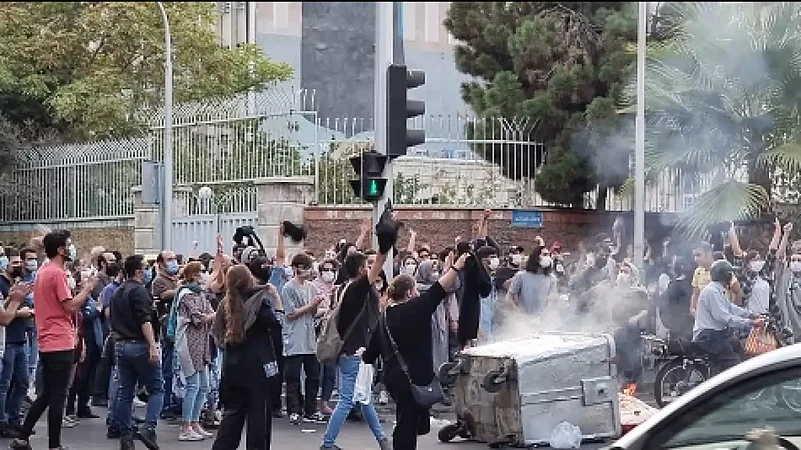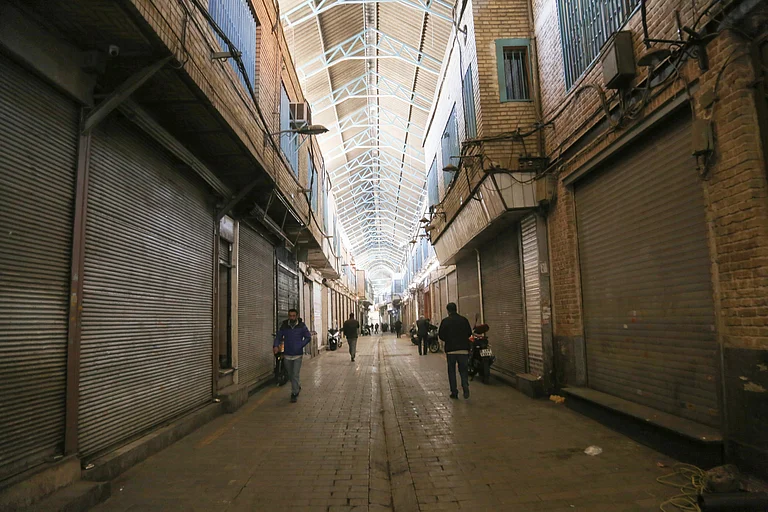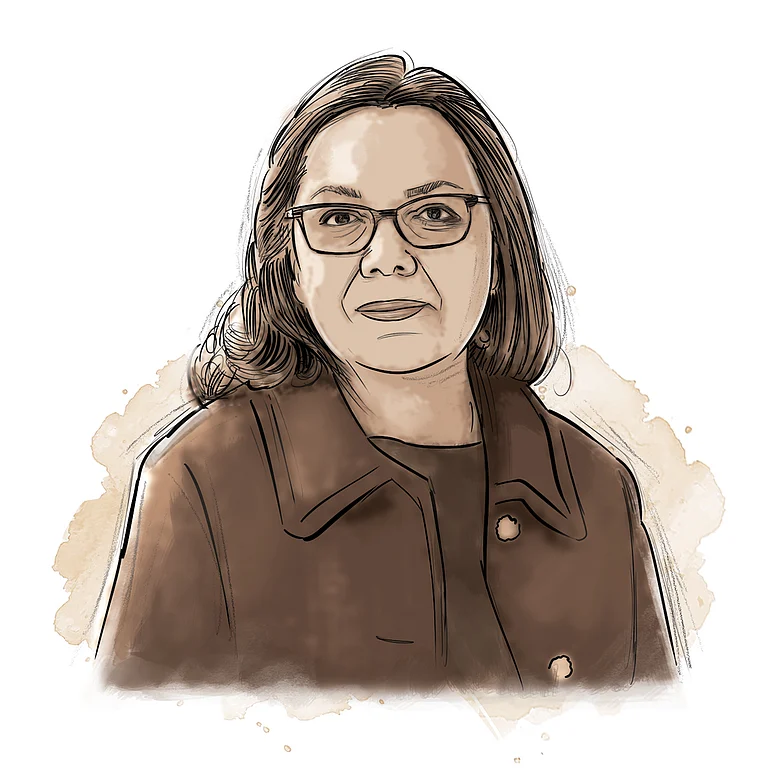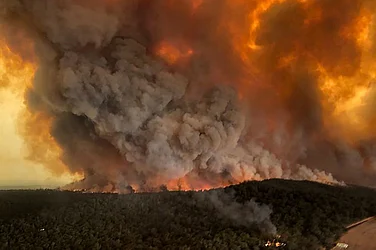The Iranian women's uprising against the Iranian state following 22-year-old Mahsa Amini's custodial death is now in its seventh month. While it might appear that hijab —Islamic head covering for women— is at the centre of protests, the issue is much deeper.
Women-led protests emerged across Iran that defied the Iran's rulers. Women took off their hijabs, burnt hujabs, cut their bare hair publicly, and walked around and danced without hijabs. The Iranian state responded swiftly. Thousands were charged and arrested and hundreds have so far been killed.
Yet protests in Iran and solidarity among Iranians in exile continue, though the extent might not be the same as it was in the first few weeks.
Though the immediate trigger was the Iran's hijab rule, which lead to Amini's death, the protests soon took on the fundamentals of the Iranian state and the Islamic Revolution of 1979 that birthed the Iran as we know it today. Here we trace how the Iranian protests and state responses have played out in recent months and what's behind the anger among Iranian women unseen in decades.
How did Mahsa Amini's death trigger mass protests?
Mahsa Amini was a 22-year-old Iranian woman of Kurdish ethnicity. She was out with her brother in September when she was detained by Iran's 'morality police' over alleged violation of the country's hijab rule.
In Iran, females are required to mandatorily wear hijab in public. They are also required to not wear form-fitting or revealing clothes. Mingling of people of opposite genders in public is also subject to regulation.
Later in police custody, Amini died from suspected custodial beatings and torture. Her death ignited protests that soon turned into largest mass-protests Iran witnessed in several years.
Protests, largely women-led, sprouted across the country. Though the immediate trigger was Amini's death over hijab rule, and the foremost visuals of defiance were the women walking with bare hair and removing and burning their hijabs, the protests soon expanded to the anger and disgruntlement with the Iranian state and revolution itself.
Iranian protests a challenge to state and Revolution
In Iran, hijab became mandatory for women after the Islamic Revolution of 1979 when hardliner Islamists overthrew the liberal, pro-West monarchy.
"Just like communism, a state was never the objective of the Revolution. The organs of the Iranian state serve the Revolution, not the other way around," note Ali Ansari and Kasra Aarabi in a paper for Tony Blair Institue for Global Change.
The movement thus highlights the legitimacy crisis and erosion of popular support for the state along with a challenge to the brand of Islam —state religion— followed and enforced by the state, said Deepika Saraswat, an Associate Fellow at the West Asia Center at the Manohar Parrikar Institute for Defence Studies and Analyses (MP-IDSA) earlier in an interview.
She earlier told Outlook, "These young women while asserting their basic right of personal autonomy are in fact challenging the state religion whose interpretation and enforcement they perhaps see as being carried out in an authoritarian manner. Hence, the slogan ‘Death to the Dictator’."
There is also a perception that is coming to the fore with the ongoing protests — the failure of the promises of the Revolution. Ali Fathollah-Nejad, an Iran expert, noted in an article for the Brookings Institute that while the Revolutionaries overthrew the monarchy, a new class of elites came up to replace the previous one instead of a wider systemic change.
Saraswat also said that protesters are seeking promises made in the Revolution, such as freedom and greater rights.
"These protests intertwine with the broader demand of ‘freedom’ in the sense of individual political and cultural rights and openness, which was also a key promise of the Islamic Revolution that overthrew the Pehlavi monarchy. The popularity of slogan of jin-jiyan-azadi [women-life-freedom] would suggest that the current round of protests are better understood within the notion of civil rights movement," said Saraswat in an interview earlier.
Iranian protests in recent months
While the world celebrated the New Year on January 1, the women in Iran continued their movement against the Iranian state. Here we retrace how Iranian women's protests and state's crackdown have played out in recent months.
Though the streets protests are not like the ones in the first few weeks, a sense of normalcy has crept in the Iranian society when it comes to not wearing hijabs, according to reports. Moreover, individual acts of defiance of Iranian dress codes by women also are becoming frequent, such going about their daily lives without hijab or in tighter clothing.
Here is a timeline of events in recent months of incidents related to the Iran protests:
January:
On January 3, Iranian chess player Sara Khadem arrived to live in Span after receiving threats to her life if she returned to Iran.
Few days back, Sara had competed in an international chess tournment in Kazakhstan without wearing her hijab. Fellow Iranian woman chess player Atousa Pourkashiyan had also participated in a tournament without wearing hijab around the same time.
Reuters reported that Sara and her family members in Iran received threats.
Reuters reported, "The source, who did not want to be named due to the sensitivity of the matter, said Khadem subsequently received multiple phone calls in which individuals warned her against returning home after the tournament, while others said she should come back, promising to ‘solve her problem’.The source also said Khadem's relatives and parents, who are in Iran, had also received threats, without giving further details."
Several women sportsperson across several disciplines, such as skating and basketball, have defied the Iranian state by taking off their hijabs in recent months.
On January 7, Iranian authorities executed two persons related to protests.
February:
The Supreme Leader of Iran pardoned "tens of thousands" of protesters booked for protests, according to NPR.
However, a legal expert told NPR that the majority of people part of the amnesty package were not related to protsts, which means that not many people would walk out of jails.
On February 6, Iranian singer singer Shervin Hajipour, who risks being imprisoned over a song on Iranian women-led protests, won a Grammy award for a song that became the unofficial anthem of the Iranian protests.
Hajipur won the Best Song For Social Change award at the 2023 Grammy Awards. He won the award for his song Baraye, which was listened by over 40 million people in less than two days, according to the Grammy website.
US First Lady Jill Biden announced the Hajipour as the winner of the Grammy Award. Announcing the award, she called the song "a powerful and poetic call for freedom and women's right".
She said, "This song became the anthem of Mahsa Amini protests, a powerful and poetic call for women's rights...Shervin was arrested but this song continues to resonate around the world with its powerful theme — women, life, freedom."
Later in the month, protests were held in Iranian capital Tehran and several other parts of the country.
Videos surfaced of protests in Tehran and cities of Karaj, Isfahan, Qazvin, Rasht, Arak, Mashhad, Sanandaj, Qorveh, Izeh, Zahedan, and holy Shia city of Mashhad, according to Reuters, which could not, however, verify, all the videos that surfaced.
March:
The Supreme Leader of Iran addressed the suspected poisoning of school girls across schools in Iran. He called it an "unforgivable crime".
"If the poisoning of students is proven, those behind this crime should be sentenced to capital punishment and there will be no amnesty for them," said Ayatollah Ali Khamenei, the Supreme Leader of Iran.
However, activists still say such incidents have continued to happen. In April, videos surfaced from another site of alleged poisoning incident.
Reports surfaced that, by March, not wearing hijab by a substantial minority of Iranian women had been normalised to the extent that even religious men did not make any comment on women walking around without hijab.
"But these days, all around the country, many women are going about their business hair uncovered...What began as anger at the hijab law grew into a bigger movement as Iranians said they were fed up with the regime's corruption, economic mismanagement and oppression of its citizens. Now, a visible minority of women in Iran are refusing to wear headscarves, in defiant protest against the government and all of its policies," reported NPR.
France 24 published interviews saying that even men did not comment on women not wearing hijab.
An interviewee said, "I literally burnt my headscarves a few months ago. I never wear a headscarf anymore. I go out on the street, I go to cafés, even to banks, and I took a flight without wearing a headscarf. Until a month or two ago, men and other women would smile at me when I went for a walk in public and say encouraging words like "Well done" or "I am proud of you". Now I've been seeing for weeks that not wearing a headscarf has become the norm – people don't even see it as something special.
"Even men who seem to be religious look away but say nothing. How this has changed so quickly is inconceivable to me. You get the feeling that society has put an invisible safety net around women without headscarves to keep them in the fight."
April:
By April, reports said that protests had reduced in intensity across Iran but some pockets had sustained them, such as Sistan and Balochistan areas.
"Half a year has passed since Mahsa Jina Amini's family says the 22-year-old Kurdish woman was murdered by regime authorities after she was arrested, allegedly for wearing her hijab improperly. Her death set off a chain of unprecedented protests in Iran...Protests continue in pockets of the country — most prominently in the southeast province of Sistan and Baluchestan," notes CBC in a story on Kurds, the community to which Amini belonged to.
Reuters on April 11 reported that Iranian authorities have started installing cameras in public planes to monitor and prosecute violations of hijab rule violations. As mentioned earlier, a large number of women now regularly go about their lives in public spaces without hijab.
"In a further attempt to rein in the increasing number of women defying Iran's compulsory dress code, authorities are installing cameras in public places and thoroughfares to identify and penalise unveiled women, the police announced on Saturday...But although risking arrest for defying the obligatory dress code, women are still widely seen unveiled in malls, restaurants, shops and streets around the country. Videos of unveiled women resisting the morality police have flooded social media," reported Reuters.
Though widespread protests have reduced in intensity, individual acts of defiance by Iranian women, often with faces covered, often surface on social media. Lately, Iranian-born historian Nina Ansary shared a video of Iranian wushu player Zahra Kiani, who was seen enacting martial arts moves in ripped jeans in defiance of Iranian regime.
The cost of this defiance is high. Hundreds have been killed and thousands are believed to be imprisoned.
"At least 537 people including 48 women and 68 children have been killed by security forces since the start of the nationwide protests 200 days ago," said Iran Human Rights in a report published recently.


























